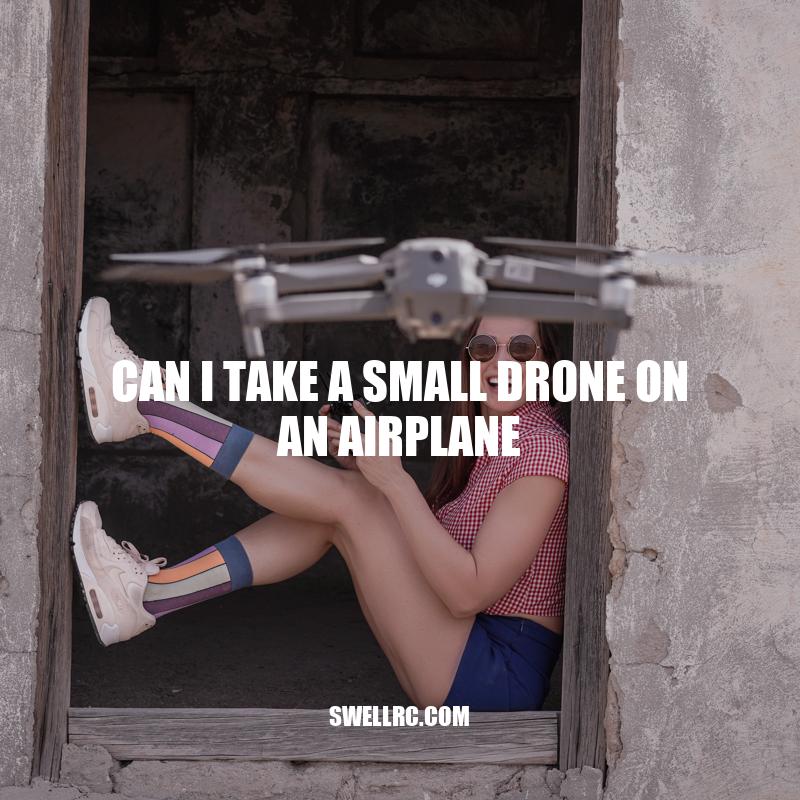Drones on Airplanes: Navigating Regulations and Safety Concerns
Drones have taken the world by storm and soared to new heights with its popularity. The compact quadcopters equipped with high-definition cameras have become a favorite pastime for tech enthusiasts and photographers. With the drone market booming, many travelers are tempted to bring their drones with them on airplane trips to capture breathtaking aerial footage. However, the question arises: Can you take a small drone on an airplane? Unfortunately, the answer is not as straightforward as a simple yes or no. While the Federal Aviation Administration (FAA) has guidelines on flying drones, individual airlines also have their policies regarding drones, especially when it comes to safety concerns. Additionally, the batteries used to power drones come with their restrictions, and there are regulations for their transportation. As such, travelers need to be well informed to avoid any risks associated with traveling with a drone. This article will help you navigate the various considerations related to taking a small drone on an airplane.
FAA Regulations
Before traveling with your drone, it’s essential to check the Federal Aviation Administration (FAA) guidelines on flying unmanned aircraft systems (UAS). Here are some of the key regulations to keep in mind:
- Drones must weigh less than 55 pounds (including the weight of any attachments).
- Flights must take place within the operator’s line of sight and during the day.
- Most drones require registration with the FAA.
- Drones cannot be flown over people or moving vehicles.
- There are restrictions on flying drones in sensitive areas, such as national parks and military bases.
For more information on FAA regulations, check out the FAA’s “B4UFLY” mobile app or visit their website at FAA.gov/UAS. Additionally, the FAA has a helpful “Can I Fly There?” tool that allows you to enter a location and see if any restrictions are in place.
Can Unmanned Aircraft That Weighs 55 lbs 25 kg Fly Under Suas Part 107 Rules?
According to the regulations set forth by the FAA’s Part 107 for small unmanned aircraft systems (sUAS), an unmanned aircraft system that weighs 55 lbs or less may fly under the Part 107 rules. However, the operator must adhere to certain guidelines, such as maintaining a line of sight with the unmanned aircraft and not flying over people or beyond a 400-foot altitude.
If you’re interested in learning more about Part 107 and the regulations surrounding flying unmanned aircraft, the FAA has resources available on their website. Additionally, there are online courses and study materials available that can help aspiring drone pilots prepare for their Part 107 certification exam.
Airline Regulations
In addition to FAA regulations, it’s important to check with your airline before traveling with a drone. Here are some common policies that airlines have regarding drones:
| Airline | Policy |
|---|---|
| Delta | Drones are allowed as carry-on luggage, but not as checked luggage. Drones with batteries larger than 160 Wh are not allowed on board. |
| United | Drones are allowed as carry-on luggage only. Drones with lithium-ion batteries larger than 100 Wh are not allowed on board. |
| American Airlines | Drones are allowed as carry-on luggage and as checked baggage (as long as they are properly packed). Lithium-ion batteries used in drones must be under 100 Wh. |
Keep in mind that policies may vary by airline and are subject to change. Always double-check with your airline before traveling with a drone to avoid any issues at the airport.
Can we carry drone in international flight to India?
Yes, you can carry a drone in an international flight to India but there are certain rules and regulations that you need to follow. According to the Directorate General of Civil Aviation (DGCA) guidelines, you need to obtain a Unique Identification Number (UIN) and Unmanned Aircraft Operator Permit (UAOP) for recreational or commercial use of drones in India. Additionally, you also need to adhere to the weight and dimension restrictions set by the airline.
Here are some key takeaways:
- You are allowed to bring your drone to India, but you must comply with local regulations governing UAV flight.
- You need to obtain a UIN and UAOP issued by the DGCA for your drone.
- You also need to follow the weight and dimension restrictions set by the airline.
For more information, visit the DGCA website or contact your airline for specific rules and regulations regarding carrying drones internationally.
Battery Regulations
Drones rely heavily on batteries, which is another important factor to consider when traveling with a drone. Here are some battery regulations to be aware of:
- Lithium-ion batteries used in drones must be under 100 Wh.
- Batteries must be properly stored and packaged in a case, cover, or insulating material to prevent short circuits.
- Batteries must be carried in carry-on luggage.
- Batteries must be in compliance with FAA regulations.
- If traveling internationally, check with the destination country’s aviation authority to ensure compliance with their regulations.
It’s important to note that regulations can change, and different airlines may have varying policies. Be sure to check the airline’s rules on battery storage and transport when traveling with a drone. If you want to learn more about drone regulations for travel, The FAA’s Fly for Fun page is a great resource, which provides information on the rules for drones used for recreational purposes.
How do you travel with a drone?
Traveling with a drone has become much more common and there are a few important things to keep in mind:
- Make sure to check the regulations of the country you are visiting. Some countries have strict laws regarding drones and you may need a permit to fly them.
- Always carry your drone in a hard-shell case that is specifically designed to fit your model. This will protect it during transportation.
- Remove the drone’s battery and store it in a fireproof bag or container. This is important as lithium batteries can be a fire hazard.
- Pack your drone in your carry-on luggage if possible. This way, you can keep an eye on it and ensure it doesn’t get damaged or lost.
If you’re looking for a quality drone to travel with, consider the DJI Mavic Air 2. It’s portable, easy to use, and has a long battery life. You can find more information about it on the DJI website.
Safety Concerns
Although drones can be a great way to capture unique travel footage, it’s important to prioritize safety. There are a few reasons why airlines have restrictions on drones onboard airplanes:
- Drones can interfere with airplanes’ communication and navigation systems, which can pose a threat to safety.
- Drones can cause distractions or panic among passengers.
- Lithium-ion batteries can present a fire or explosion hazard if not stored or transported correctly.
To avoid these risks, be sure to follow all FAA regulations, check with the airline for their specific rules, and consider local laws and restrictions. Additionally, be cautious when flying a drone and make sure you’re familiar with its controls and flight patterns. Lastly, always practice responsible drone flying habits, such as keeping a safe distance between the drone and people or wildlife. If you’re unsure about the regulations, consider taking an online course on drone safety and regulations, such as the one offered by the FAA.
Can I take a drone on board a plane?
Yes, you can take a drone on board a plane, but you need to follow specific guidelines set by the airline and the Federal Aviation Administration (FAA). Here’s what you need to keep in mind:
- Check with your airline beforehand to see if they allow drones on board.
- Ensure that your drone is within the required size limit for carry-on luggage.
- The batteries for your drone must comply with FAA regulations and be less than 100 watt-hours.
- Always keep your drone and its accessories in your carry-on bag, never in your checked luggage.
- Consider purchasing a specialized drone travel case to protect your device during travel.
For more information, check out the FAA’s guidelines for flying with drones.
Conclusion
In conclusion, travelling with a drone onboard an airplane requires careful consideration and planning to ensure the safety of everyone onboard. Before packing your drone in your luggage, research the FAA and airline regulations that apply in your specific case. You should also make sure that the batteries are well-packed, and you have all the necessary accessories to make the transportation process as seamless as possible.
However, if you’re unsure about whether you should bring your drone, it’s better to leave it at home rather than risk causing a disruption or putting others in danger. As a responsible drone operator, it’s important to prioritize safety and always follow the rules and guidelines set by the FAA and the airline. With a little planning and caution, you can still enjoy the benefits of drone photography, even on your travels.



